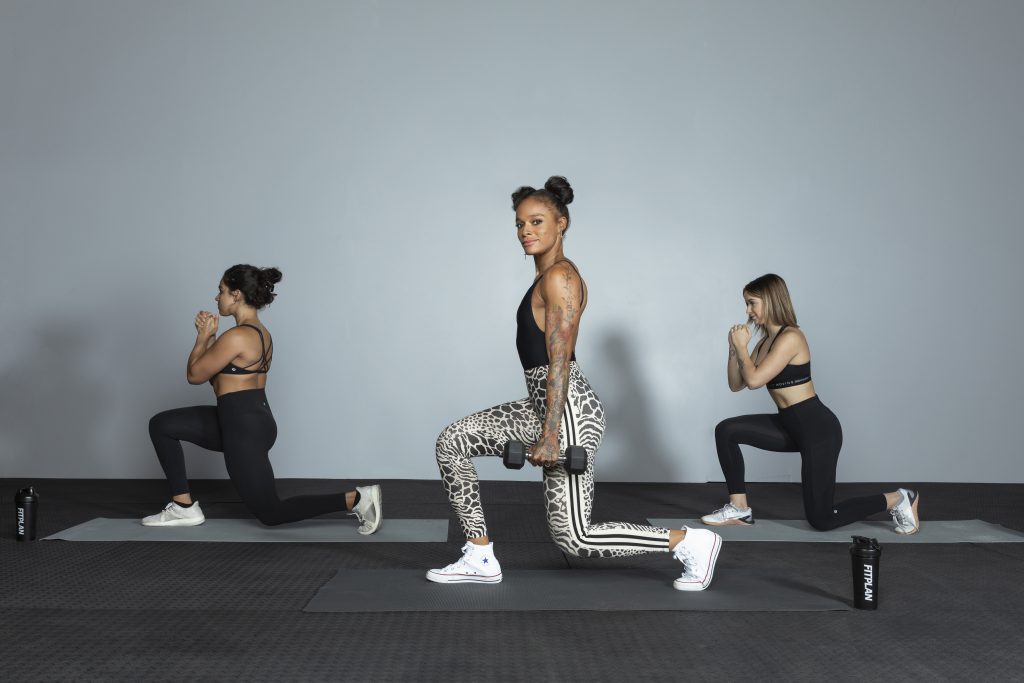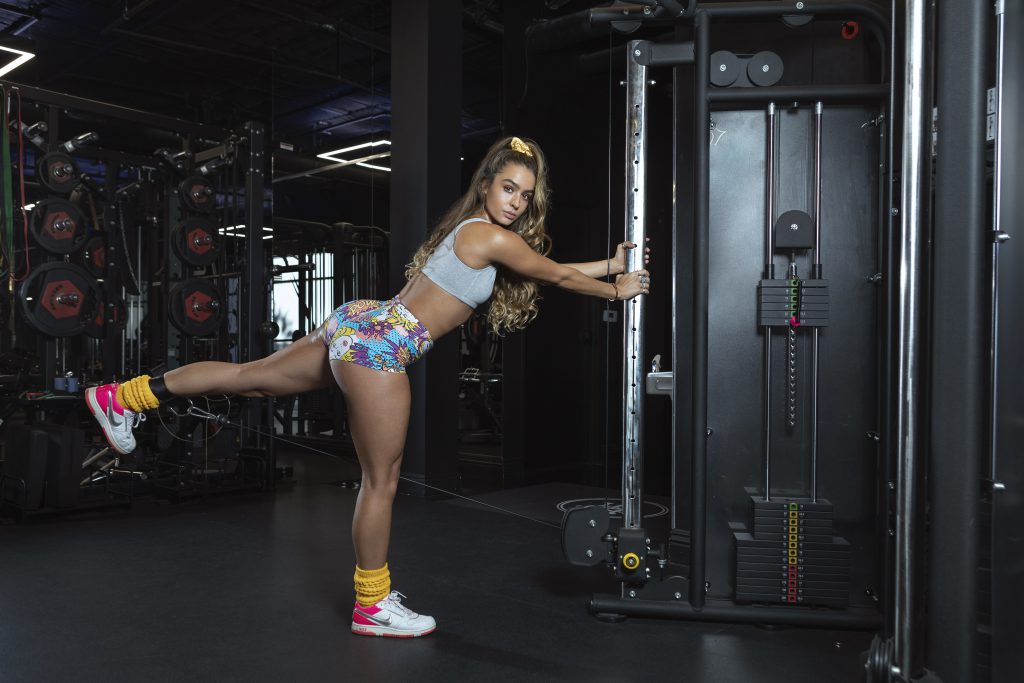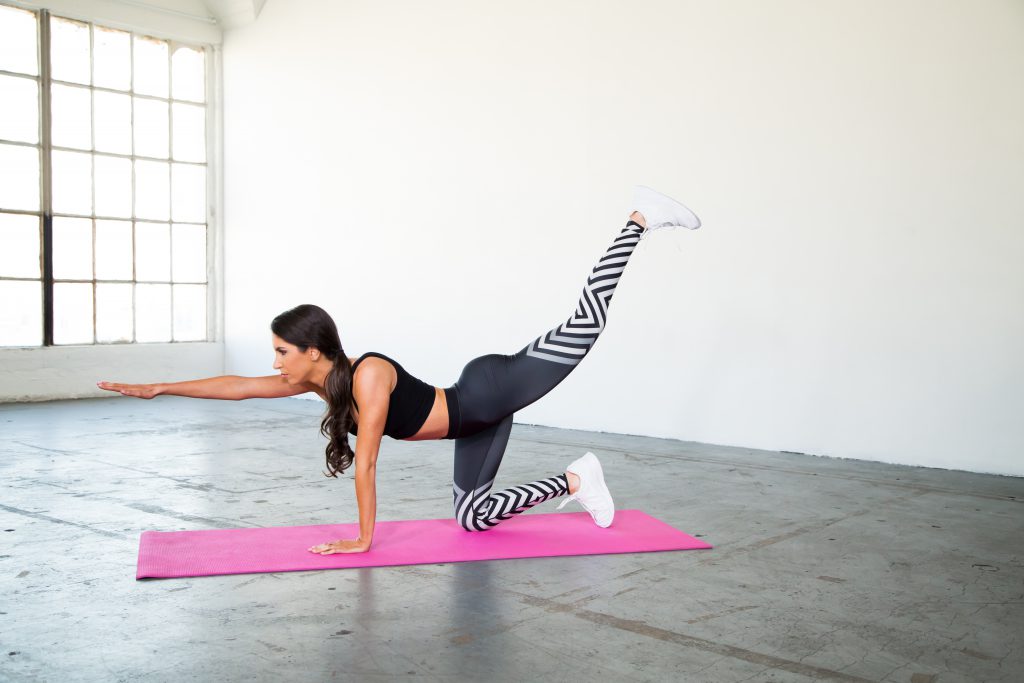Few muscle groups are as important as the glutes. Their location in the center of the body makes them essential for lower body movement and support for the upper body. Just about any kind of movement that involves your legs, thighs, or hips is derived from strength in the glutes.
Glutes are such a key muscle group for body movement that there are almost no exercises that isolate them completely. That being said, there are plenty of great glute exercises that primarily target the glutes and reduce the activation of nearby muscles that can take some strain off the glutes.
Whether you’re trying to build muscle mass in your glutes to have a shapely posterior or you want more functional strength for sports and complicated lifts, you can use the 7 exercises in this guide to get a poppin’ booty.
(Note: Want our elite trainers to help you tone and strengthen your glutes? Start your Fitplan free trial today!)
Anatomy of the Glute Muscle Group
From an outside perspective, there seems to be just one big glute muscle on each leg. There are actually three muscles that behave slightly differently and you have to work all of them if you want maximum strength and a nice butt. The glutes are made up of the following muscles:
Gluteus Maximus
The largest of the gluteal muscles and one of the strongest muscles in the body, the gluteus maximus has the highest name recognition and provides the most shape and power out of the glute muscle group. If you want a round booty and explosive energy when you move your thighs and hips, the gluteus maximus is what you want to target.
Gluteus Medius
Slightly smaller than the gluteus maximus, the gluteus medius is responsible for moving the hip forward and backward as well as rotating it, principally by exerting force on the femur, the longest bone in your body located in your thigh. When you run, the gluteus medius works to slow down your femur during the second half of a stride.
Gluteus Minimus
Together with the gluteus medius, the gluteus minimus helps move the hip away from the body in a process called hip abduction. It also prevents too much movement in the other direction.
Adduction, or movement toward the body’s midline, can be injurious to the hip joint if taken to the extreme. Both the minimus and the medius help power hip extension and hip rotation during walking and running as well as stabilizing the thighs and hips during sudden pivots in different directions.
Helpful hint: Build stronger glutes fast with our 30-Day Booty Sculpt Fitplan!
Benefits of Strong Glutes
Besides the specific functions of the individual muscles that make up the glutes, this key muscle group plays some other roles. Building more mass and strength in your glutes makes them better at doing their job, which has plenty of advantages for fitness performance and daily life.
The glutes support the upper body, especially the back. If you suffer from regular back pain and haven’t experienced a particular injury that could have caused it, weak glutes might be the main culprit.
Modern technology and increased reliance on remote platforms for work, school, and entertainment have caused people to spend more time than ever before sitting down. Uninterrupted sedentary periods at work, in the car, or in front of the TV and computer are correlated with increased premature mortality risk.
If you have to spend significant amounts of time sitting down and being sedentary, you can at least break up the longest periods with some physical activity to mitigate the worst effects of a sedentary lifestyle. During that time, isolation exercises for the glutes are very important because prolonged periods of sitting cause your glutes and nearby muscles to weaken.
In addition to supporting the upper and lower back, the glutes provide pelvic stability. If you suffer from knee pain, stronger glutes can reduce that, too. When they have enough strength, your glutes prevent your leg from pointing too far in or out, helping your knees stay straight as well.
Glute Isolation Exercises Vs Compound Exercises
OK, the glutes are really important, but is it really necessary to target them specifically? In some situations, yes. Particularly if you find that a sedentary lifestyle or a period of inactivity has left you with weakened hip extensors or glutes, you might want to add some of these glute isolation exercises into your workout plan.
Other exercises for your arms, shoulders, upper back, and lower body muscle groups like the quads and hamstrings are also important for general health and well-rounded fitness. Compound exercises that cause activation in lots of muscles are often more of a challenge and a smarter way to work out fast and make the most of your time at the gym, but if you want to focus on your glutes the isolation exercises are better.
For example, in a leg press, your foot stance affects which muscles are targeted during the exercise. If your left and right foot are high up on the platform, you’ll target your glutes and hamstrings more, while a lower foot position will take the pressure off the hamstrings and glutes and place more strain on the quadriceps.
Helpful hint: Prioritize booty gains and fat loss with our second Strong & Lean Fitplan!
7 Best Exercises to Target Your Glutes
When you need a glute workout, focus on these isolation exercises to make sure your quads and calves aren’t taking over too much and robbing you of the glute strength gains you’re looking for.

1. Reverse Deficit Lunges
If you’ve ever made a workout plan for leg day before, you’re probably already familiar with the lunge. Lunges have long been held among the best exercises for increasing hypertrophy in the gluteus maximus muscle.
The movement of a lunge is very simple. Nailing down the form of a traditional lunge is important because many lunge variations are great for glute development as well as the quads and hamstrings.
Traditional lunges are usually a bodyweight exercise but you can add dumbbells or resistance bands to give your glutes even more of a workout. To do a lunge, start in a standing position with your feet about hip-width apart.
Take a step forward with your right foot. Make sure it’s slightly longer than your normal stride. Lower your torso to accommodate the movement and keep sinking until your right thigh is parallel with the ground. Your left knee should nearly touch the floor. Rise back up to the starting position by pressing through your right heel.
If you want to isolate and activate your glutes, try the reverse deficit lunge. In this move, you need to stand on a raised platform and step backward with one leg. Lower into the same squat position as you would in a traditional squat and rise back to the starting position to complete one rep.
2. Single-Leg Glute Bridge
Focus on your gluteus maximus and medius with this glute bridge variation. By adding in the single-leg movement, you can give each leg more of a workout. It might cost you more time during your workout plan, but this bodyweight exercise is so simple that you can add it to a home routine to avoid wasting valuable gym time.
Your hip adductors, quads, hamstrings, and core muscles will all see some activation during this move, although the main focus is the two larger gluteal muscles. If you want to make it even more challenging, wrap a resistance band around your legs above the knee.
To get into the starting position, lie down on your back and bend your knees so that the soles of your feet can rest flat on the ground. You can leave your hands palms-down at your sides. Lift either your right or left leg up in the air with the knee straight.
Next, squeeze your glutes together and lift your hips until there’s a straight line running from your neck to your lower knee. Hold that pose for a couple of seconds before lowering back into the starting position. As with all single-leg exercises, make sure you switch to the other leg to get an even workout on both sides of your body.
Helpful hint: Accentuate your figure with our Sculpted Curves Fitplan!

3. Glute Kickbacks
Another single-leg exercise, the glute kickback can be performed with either a pulley machine or a resistance band that’s securely fastened to an anchor point. If you’re working out from home or at work, a heavy desk or table is ideal for holding one end of the resistance band.
The kickback causes glute activation in all three muscles. If you’re using a pulley machine, put the pin where you want it in the weight plates and secure the velcro strap around your right ankle. Lean forward and place your hands on a vertical bar of the machine for stability.
When you lean forward, make sure to hinge at the hips rather than rounding your back. Your body won’t make a 90-degree angle, but your torso should be fairly close to being parallel with the ground. Keep your feet about hip-width apart.
Now that you’re in the starting position, raise your right leg behind you. Keep going until the right leg is parallel with your torso. Some people can go a bit higher, but a straight line is what you’re aiming for here.
Hold the right leg at its highest point for 1 – 2 seconds and then bring it back down to the starting position. Make sure to do the same amount of reps on each side of your body.
4. Hip Thrust
The hip thrust is extremely similar to the glute bridge we already discussed earlier in this exercise guide. Both the glute bridge and the hip thrust require elevation of the hips using glute strength, but the hip thrust is done with an elevated surface while a glute bridge is done with the shoulders resting on the floor. The additional elevation of the hip thrust gives your glutes room to move through a larger range of motion.
A sturdy bench, chair, or table works for this exercise as long as it isn’t too high off the ground. You should be able to put the back of your head on the elevated surface and hold your butt just off the ground with the soles of your feet flat. If the bench or chair is too high, you’ll be robbing yourself of a significant part of this exercise since your glutes won’t be able to sink as far.
Sit just in front of the elevated surface of your choice and rest the back of your head on the surface. Plant your feet on the ground shoulder-width apart and lift your butt slightly off the ground to get into the starting position. To execute the move, engage your core and glutes to lift your hips until your torso is flat.
Squeeze your glutes at the top of the motion and then return to the starting position. For additional difficulty, hold a barbell across your lap.

5. Donkey Kicks
One of the best glute exercises for people who like to exercise at home, work, or just about anywhere else, donkey kicks are also one of the most common bodyweight exercises to pair with a resistance band. You might find the starting position a bit awkward, but it’s not much different from a standard push-up.
Folks with knee problems might want to get out a yoga mat or some other kind of padded surface if they’re going to keep donkey kicks as part of their regular workout plan. This move can be used as part of a warm-up or cooldown, but you can also throw it in the main section of a bodyweight routine as well.
Support your upper body with your palms flat on the ground directly beneath your shoulders. Unlike push-ups, your lower body will be supported by your knees. Make sure the knees are bent at a 90-degree angle.
Squeeze your glutes and send either leg backward as you straighten out the knee. At the top of the movement, you should have a straight line from the heel of the active leg to the top of your head. Return to the starting position and keep going through all your reps on one side before switching to the other leg.
Donkey kicks might not seem like much, but they’re great for building strength in the gluteus maximus and stability more generally. As a bonus, your shoulders and core will also get a bit of a workout.
Helpful hint: Learn more highly-effective exercises that need no additional equipment with our Bodyweight Burner Fitplan!
6. Fire Hydrant
This exercise might seem oddly-named but once you go through the motion a few times you’ll probably understand the canine origins of the name. It’s similar to donkey kicks but it requires a more lateral movement, which is great for the gluteus medius. Your ability to perform side-to-side motions improves with this exercise.
The starting position is the same as the one for donkey kicks. Get down on your hands and knees, making sure your hands are directly beneath your shoulders and your knees are at a 90-degree angle. That angle is more important in this fire hydrant move than it was in the donkey kicks.
Once you’re in the starting position, raise your right leg out to the side without losing the 90-degree angle in your right knee. The movement might feel strange at first, so don’t try to raise the right leg higher if you feel any pain. You aren’t aiming to get the leg parallel with your torso like in some other exercises, just get it as high as you comfortably can.
Lower the right leg and complete all the reps on the right side before switching to the left. Put this exercise in your workout plan alongside donkey kicks and you’ll be building both forward and lateral strength in your glutes.
7. Side-Lying Hip Abductions
While they might not be as effective as compound exercises like the Romanian deadlift or the Bulgarian split squat, hip abductions are nonetheless great moves for targeting the glutes specifically. They’re easy to do and offer plenty of activation for the gluteus medius and minimus.
For a traditional hip abduction exercise, lie on your side with both legs stretched out. One leg should be on top of the other. You can leave your hands tucked in or support your upper body with your elbow as needed.
Lift the top leg directly up as far as possible and then bring it back down. Complete all your reps on that side before switching to the other one. This is often viewed as strictly a warm-up or beginner move, but people still mess it up all the time by going too fast or letting their body get out of alignment.
Helpful hint: Build a shapely posterior with our Booty Perfection Fitplan!
Conclusion:
Building strong glutes is vital for a round booty, functional strength, and injury prevention at some of the most sensitive joints in your body. The glutes support your upper body and stabilize your knees and hips. Glute workouts are especially important if you spend lots of time sitting down since a sedentary lifestyle can cause them to atrophy.
Compound exercises like deadlifts work the whole posterior chain and they’re great for making the most of your time at the gym. But if you want to concentrate on your glutes without having to build tons of deadlift strength, the glute isolation exercises in this guide are the best way to do it.
(Note: Want our elite trainers to help you tone and strengthen your glutes? Start your Fitplan free trial today!)


